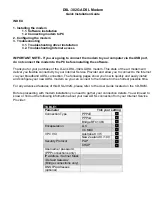
22
SD Series Ref. Manual (Packet & Transparent Mode)
MDS 05-4846A01, Rev. C
5.1 Initial Configuration
This section provides the steps necessary to program the radio for its
first on-air operation. There are numerous settings and menus that go
beyond basic configuration, and you may wish to access these later. A
full description of menu tasks is provided in Section
6.0 MANAGING
THE TRANSCEIVER
.
Serial vs. Telnet Access
There are two methods available to communicate with the transceiver
for configuration and management purposes:
Serial
(
COM1
DB9 con-
nector) and
Telnet
(
ETHERNET
RJ-45 connector). Both present identical
menu screens, but the method of access is different for each. The focus
of this section is on Serial access, but Telnet may also be used by fol-
lowing these additional points, which replace Steps 1-3 below:
• Connect to the radio with a PC that is on the same IP network as
the transceiver. Launch a Telnet program, and connect to the
radio using its programmed IP address.
• The default IP address for an SD is 192.168.1.1. If you do not
know the IP address of the radio, follow the serial configuration
instructions below, where you can determine the radio's address
and continue configuration of the radio.
Connecting a PC & Setting Basic Parameters
Follow these steps to configure the transceiver for its first use:
1. Connect a PC to the radio’s
COM1
serial port as shown in Figure 20.
(Maximum recommended cable length: 50 ft./15 m)
NOTE:
Not all PCs include a serial port. If one is not available, a USB port may be
used, along with a USB-to-Serial adapter (with appropriate driver soft-
ware). Adapters are available from many manufacturers.
NOTE:
If
COM1
has been configured to boot into data mode, pressing
within 10 seconds of boot-up switches it into console (management) mode.
Console mode is required for the following steps.
2. Launch a terminal communications program, such as HyperTer-
minal (included with many Windows
®
-based PCs) with the fol-
lowing communication parameters:
8 bits, no parity, one stop bit
(8N1), flow control disabled, VT100 emulation.
The radio’s
COM1
port automatically determines the connected baud rate (within the
range of 1200–115200 bps). The preferred baud rate is 9600 bps.
To use the autobaud feature, press the
key
several times at
half-second intervals to lock into the correct baud rate.
ENTER
ENTER














































